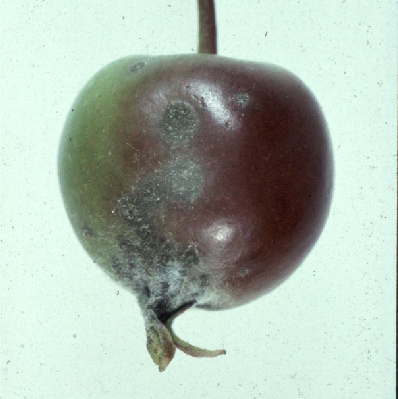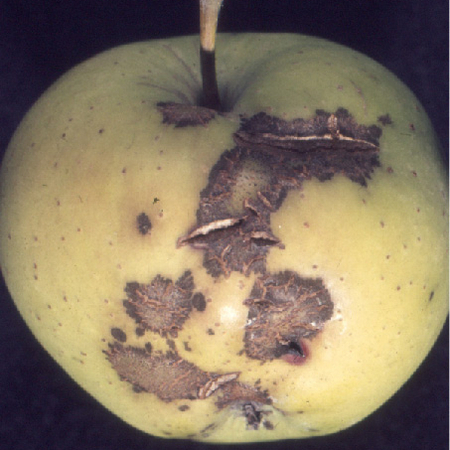Apple scab disease
Venturia inaequalis
Damage symptoms
On the leaves: velvety, olive-green, washed-out spots up to 1 cm in diameter; mainly on the upper side of the leaf. The center of the damaged areas gradually withers or scars. Spots resulting from secondary infections remain smaller but are more numerous per leaf. In early infestations, leaves turn yellow and drop.
On fruit: Brown-black spots that appear in spring later cause cracking of the fruit skin because the damaged tissue cannot grow with the fruit. Spots appearing from late summer onwards remain smaller and, in the case of very late infestation, may not become visible until storage (storage scab). Severe infestation leads to crippling, the fruit may stop developing.



Propagation and transmission
The most important source of infection are the spores (ascospores) of the scab fungus(Venturia inaequalis), which are formed in tiny fruiting bodies (pseudothecia) in the fallen leaves during dormancy. As soon as the first spores mature (around the beginning of April), they can be ejected from the fruiting bodies after precipitation and infect young leaves. Since the spores do not mature at the same time, they can cause infections until about mid-June. About ten to 20 days after infestation, the first leaf spots become visible, on the surface of which the summer spores (conidia) develop. They are responsible for further infections until the end of the growing season. The development of more than ten fungal generations per year is not uncommon.
In case of heavy infestation, the scab fungus can also overwinter on the tree (on infected shoots) and cause early infections in spring.
Economic importance
If frequent precipitation occurs in spring, yield losses of up to 70% are possible. Early leaf drop or loss of leaf area due to the death of leaf areas increases frost sensitivity and restricts growth. A season with severe scab infections can have a negative impact for several years.
Prevention and control
Prevention
- avoid locations with fog frequency and long periods of leaf wetness
- Balanced pruning measures (since only young leaves are susceptible, early completion of shoot growth is favorable) and ensure good aeration of the tree crown
- Accelerate decomposition of fallen leaves (by mulching and tilling, earthworm promotion, urea treatment)
- Variety selection: The main varieties in intensive fruit growing are all moderately to severely susceptible to scab and must be treated with pesticides correspondingly often. In addition, scab-resistant apple varieties such as Topaz, Goldrush, Rubinola or Goldstar are becoming increasingly important. Partially resistant varieties are Discovery and Empire.
Control
- A prerequisite for targeted scab control is up-to-date information on the risk of scab. An application of synthetic fungicides (see list of plant protection products approved in Austria) should be carried out timely and thoroughly, especially in the period between mid to late April and late June. The treatment times should be selected according to the infection conditions (weather-dependent; heed warnings ). Experience has shown that severe infections often occur around flowering time.
- Copper preparations are mainly used against shoot scab until flowering.
- In humid locations with a risk of late scab, treatments with synthetic fungicides four to five weeks before harvest are advisable.
- To prevent possible resistance, it is advisable not to use only systemically acting preparations and to alternate fungicides from different groups of active ingredients.
Last updated: 11.04.2023
automatically translated